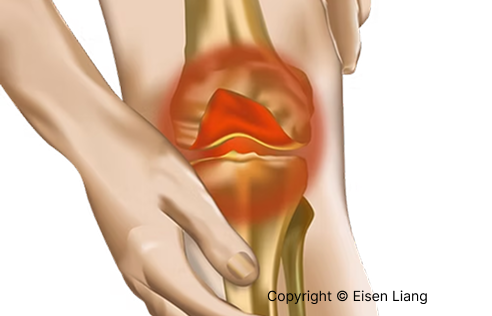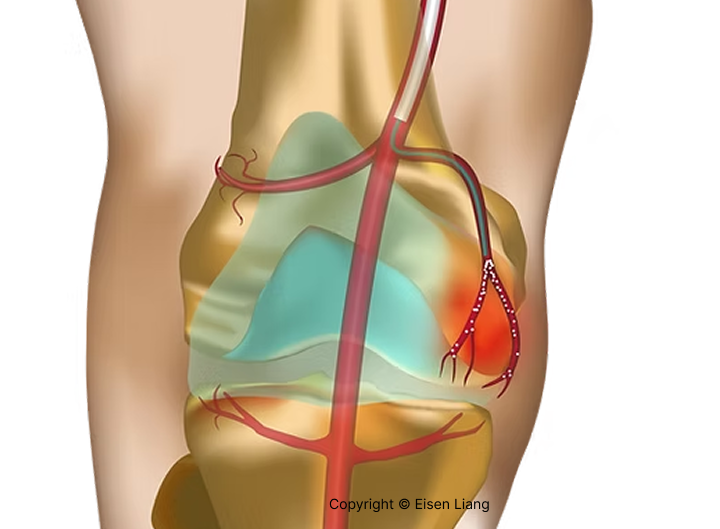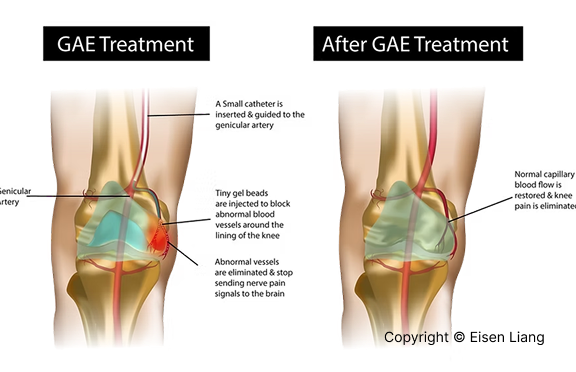Genicular Artery Embolisation (GAE) is a minimally invasive radiological procedure that helps relieve knee pain caused by osteoarthritis. Rather than replacing the joint, GAE works by reducing excessive blood flow to inflamed tissue in the knee lining (synovium). By injecting tiny particles into selected blood vessels, the inflammation and pain can be reduced. The procedure is carried out by an interventional radiologist — a specialist doctor trained to use imaging techniques to perform procedures inside the body without traditional surgery.
What is GAE for knee osteoarthritis?


When should I consider GAE for my osteoarthritis knee pain?
GAE may be an appropriate option if you have osteoarthritis in the knee and are experiencing ongoing moderate to severe pain or stiffness that has not improved with conservative therapies, such as anti-inflammatory medication, physiotherapy, or joint injections; and you are not suitable for or would prefer to avoid or defer knee replacement.
How effective is GAE?
Research shows GAE is highly effective for many patients. The procedure has a technical success rate of over 99%. At 12 months, 78% patient reported pain relief and 92% reported improvement of knee function. Pain relief typically begins within one to two weeks as the inflammation reduces. Patients with greater knee pain severity may be more responsive to GAE. Sustained pain relief in a substantial proportion of patients at 2 years, with a low retreatment rate (8.3%) and only 5.2% of patients requiring total knee replacement within 2 years.


How is GAE performed?
GAE is done as a day procedure under local anaesthetic and twilight sedation, meaning you’ll be relaxed but not fully asleep. A thin, flexible catheter is inserted into an artery in the groin or near the ankle. Using X-ray guidance, the radiologist steers the catheter toward the arteries supplying the knee joint — known as the genicular arteries. Tiny particles are then injected to block the blood vessels that supply the inflamed tissue.
Before undergoing GAE, you’ll have a consultation with an interventional radiologist who will explain the procedure, assess your medical history, and answer any questions. You may need imaging studies, such as an X-ray and MRI or angiogram, to evaluate your arthritis. You’ll likely need to fast for a few hours before the procedure and discuss your medications with your doctor — especially if you’re taking blood thinners. Be sure to organise for someone to take you home afterwards, as you won’t be able to drive on the day of the procedure due to the sedation.
Recovery after GAE is generally straightforward and quicker than after surgery. Most people go home the same day and are advised to rest for 24 hours. You may experience some mild bruising or soreness at the catheter site, but this usually settles within a few days. Over-the-counter pain relief is often enough to manage any discomfort. Most patients return to light activities within a few days and can resume their usual routine shortly after.
Minor complications may occur such as bruising at the entry site, transient itchy rash and discolouration around the knee. A flare-up of knee pain may occur in the first week. Non-target embolisation causing skin ulceration and temporary numbness are very rare. Some patients experience post-embolisation syndrome, which may include mild fever, fatigue or nausea, usually resolving within a few days.
GAE is typically suited for adults aged between 40 and 80 who have moderate to severe osteoarthritis-related knee pain that hasn’t responded to conservative treatments. Candidates often have joint damage seen on X-ray, without severe deformity or bone collapse. You should also be in generally good health and not have any active infections, kidney disease, bleeding disorders, or malignancies. If you’re a current or former smoker or if your arthritis is extremely advanced, GAE may be less effective or not advised. A specialist consultation is the best way to determine if GAE is appropriate for your specific situation.
If you’re interested in learning more, call to discuss with one of our receptionists, or speak with your GP to ask for a referral to one of our interventional radiologists. GAE could help you reduce pain, improve mobility, and delay or avoid surgery.